Management Activities Report: Health, Safety, and Delegation Analysis
VerifiedAdded on 2020/02/05
|32
|6666
|196
Report
AI Summary
This report comprehensively analyzes various management activities. It begins by exploring how an organization's mission influences its structure, examining hierarchical, management group, matrix, and project-based structures. The report then delves into organizational culture, comparing power, task, person, and role cultures, and evaluates the suitability of an organizational context for a selected work group, considering size, structure, and culture. Furthermore, it discusses customer orientation in operational areas, focusing on feedback from internal and external customers, the 'inside out' versus 'outside in' approaches, and customer segmentation. The report also evaluates operational management techniques, project management, work plans, and objective setting. It assesses the suitability of quality standards, factors in delegation, evaluates the delegation process and monitoring methods, and explains the impact of health and safety legislation, including risk assessment and adherence evaluation. The conclusion summarizes the key findings and recommendations derived from the analysis.

Management Activities
Name of student:
Unit/Subject:
Course:
Tutor’s Name
1
Name of student:
Unit/Subject:
Course:
Tutor’s Name
1
Paraphrase This Document
Need a fresh take? Get an instant paraphrase of this document with our AI Paraphraser

Management Activities
Contents
Task 1...............................................................................................................................................4
1.1 Explain how the mission of an organisation has influenced its structure..............................4
1.2 Explain how the culture of an organisation has developed...................................................6
1.3 Evaluate the suitability of an organisational context to current requirements for a selected
work group...................................................................................................................................9
Task 2.............................................................................................................................................10
2.1 Discuss the extent to which an operational area of an organisation is customer oriented...10
2.2 Evaluate the use of operational management techniques in a specific context...................12
2.3 Explain how project management techniques could improve business activities...............14
Task 3.............................................................................................................................................15
3.1 Develop work plans to achieve given organisational objectives.........................................15
3.2 Develop objectives which are specific, measurable, achievable, realistic and time-bound.
...................................................................................................................................................17
3.3 Evaluate the suitability of existing quality standards for a given business activity............19
Task 4.............................................................................................................................................21
4.1 Explain factors to be taken into account when making decisions about delegating work.. 21
4.2 Evaluate the process used to delegate work in a selected work group................................22
4.3 Evaluate methods used to monitor work activities in a selected work group......................23
Task 5.............................................................................................................................................24
5.1 Explain the impact of health and safety legislation on a given business activity................24
5.2 Carry out a health and safety risk assessment in a given solution.......................................25
5.3 Evaluate adherence to health and safety legislation for a given business activity..............31
CONCLUSION..............................................................................................................................32
REFERENCE................................................................................................................................33
2
Contents
Task 1...............................................................................................................................................4
1.1 Explain how the mission of an organisation has influenced its structure..............................4
1.2 Explain how the culture of an organisation has developed...................................................6
1.3 Evaluate the suitability of an organisational context to current requirements for a selected
work group...................................................................................................................................9
Task 2.............................................................................................................................................10
2.1 Discuss the extent to which an operational area of an organisation is customer oriented...10
2.2 Evaluate the use of operational management techniques in a specific context...................12
2.3 Explain how project management techniques could improve business activities...............14
Task 3.............................................................................................................................................15
3.1 Develop work plans to achieve given organisational objectives.........................................15
3.2 Develop objectives which are specific, measurable, achievable, realistic and time-bound.
...................................................................................................................................................17
3.3 Evaluate the suitability of existing quality standards for a given business activity............19
Task 4.............................................................................................................................................21
4.1 Explain factors to be taken into account when making decisions about delegating work.. 21
4.2 Evaluate the process used to delegate work in a selected work group................................22
4.3 Evaluate methods used to monitor work activities in a selected work group......................23
Task 5.............................................................................................................................................24
5.1 Explain the impact of health and safety legislation on a given business activity................24
5.2 Carry out a health and safety risk assessment in a given solution.......................................25
5.3 Evaluate adherence to health and safety legislation for a given business activity..............31
CONCLUSION..............................................................................................................................32
REFERENCE................................................................................................................................33
2
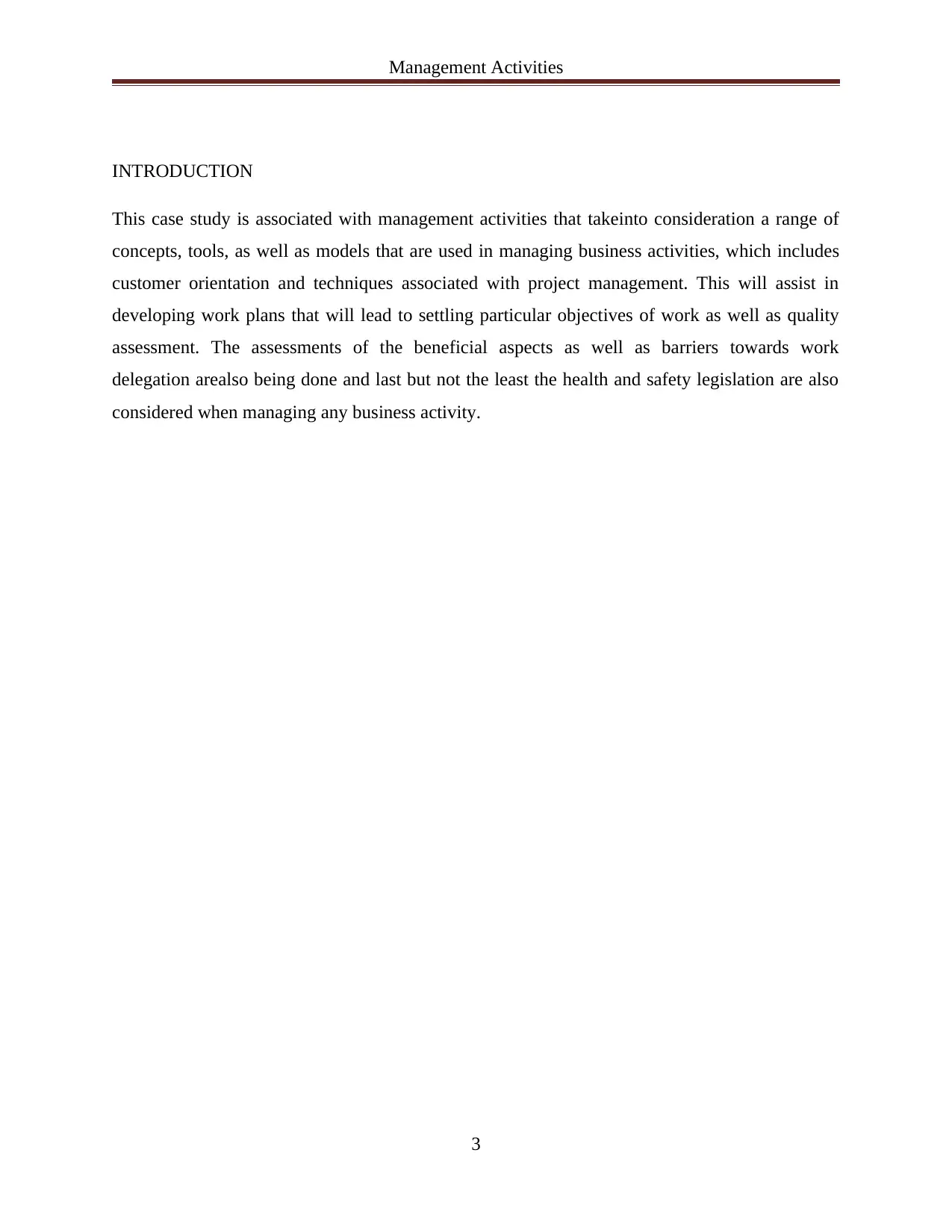
Management Activities
INTRODUCTION
This case study is associated with management activities that takeinto consideration a range of
concepts, tools, as well as models that are used in managing business activities, which includes
customer orientation and techniques associated with project management. This will assist in
developing work plans that will lead to settling particular objectives of work as well as quality
assessment. The assessments of the beneficial aspects as well as barriers towards work
delegation arealso being done and last but not the least the health and safety legislation are also
considered when managing any business activity.
3
INTRODUCTION
This case study is associated with management activities that takeinto consideration a range of
concepts, tools, as well as models that are used in managing business activities, which includes
customer orientation and techniques associated with project management. This will assist in
developing work plans that will lead to settling particular objectives of work as well as quality
assessment. The assessments of the beneficial aspects as well as barriers towards work
delegation arealso being done and last but not the least the health and safety legislation are also
considered when managing any business activity.
3
⊘ This is a preview!⊘
Do you want full access?
Subscribe today to unlock all pages.

Trusted by 1+ million students worldwide

Management Activities
Task 1
1.1 Explain how the mission of an organisation has influenced its structure.
The mission of an organisation has influenced its structure in the following ways,
Hierarchy – When the mission of an organisation is doing business in a highly-controlled
environment like financial service or defence, then a proper organisational structure is
considered to be following a strict hierarchy. The markets are considered to be possessing
stability and the top-down authoritarian approach makes sure that the organisation and its staffs
will be complying with the pertinent rules and regulations. The works of the staffs are governed
by the detailed policies and procedures. Since, each and every activity is being coordinated from
the top down, the structure is considered to be very much effective, but the downside of this
structure is that it possesses the flexibility and responsiveness that is very limited towards the
market. (Barden, 2015)
Management Group–When the mission of an organisation is associated with the growth of
business then an organisational structure that is more decentralized is considered proper. Having
a management group that is diversified at the top of a hierarchical structure, the organisation will
possess the ability of drawing on broader know-how while considering the retention for the
centralization of control that the organisational mission might require. There is the responsibility
towards executing the mission in this kind of organisational structure and ensuring that the staffs
are following the company’s instructions for actualising the goals that are defined in a clear way.
Matrix– Most of the time organisations are having a mission that is broad and its orientation is
more toward a market as well as product. There is the need for having rapid adjustments for the
organisation in respect of market changes as well as the environment that is competitive and is
required to possess additional flexibility in comparison to the allowed strict structures of
hierarchy. The matrix organisational structure assists in maintaining the hierarchy in respect of
the functional aspects of human resource like promotions and salary, discipline, but another
structure is being superimposed in respect of work. (Barden, 2015)
Project– When the mission of an organisation takes into consideration particular as well as goals
that are clearly defined, an organisational structure that is project-based might be considered to
4
Task 1
1.1 Explain how the mission of an organisation has influenced its structure.
The mission of an organisation has influenced its structure in the following ways,
Hierarchy – When the mission of an organisation is doing business in a highly-controlled
environment like financial service or defence, then a proper organisational structure is
considered to be following a strict hierarchy. The markets are considered to be possessing
stability and the top-down authoritarian approach makes sure that the organisation and its staffs
will be complying with the pertinent rules and regulations. The works of the staffs are governed
by the detailed policies and procedures. Since, each and every activity is being coordinated from
the top down, the structure is considered to be very much effective, but the downside of this
structure is that it possesses the flexibility and responsiveness that is very limited towards the
market. (Barden, 2015)
Management Group–When the mission of an organisation is associated with the growth of
business then an organisational structure that is more decentralized is considered proper. Having
a management group that is diversified at the top of a hierarchical structure, the organisation will
possess the ability of drawing on broader know-how while considering the retention for the
centralization of control that the organisational mission might require. There is the responsibility
towards executing the mission in this kind of organisational structure and ensuring that the staffs
are following the company’s instructions for actualising the goals that are defined in a clear way.
Matrix– Most of the time organisations are having a mission that is broad and its orientation is
more toward a market as well as product. There is the need for having rapid adjustments for the
organisation in respect of market changes as well as the environment that is competitive and is
required to possess additional flexibility in comparison to the allowed strict structures of
hierarchy. The matrix organisational structure assists in maintaining the hierarchy in respect of
the functional aspects of human resource like promotions and salary, discipline, but another
structure is being superimposed in respect of work. (Barden, 2015)
Project– When the mission of an organisation takes into consideration particular as well as goals
that are clearly defined, an organisational structure that is project-based might be considered to
4
Paraphrase This Document
Need a fresh take? Get an instant paraphrase of this document with our AI Paraphraser

Management Activities
be very much appropriate. When an organisation is interested in designing as well as building a
specific product in the next couple of months through the assignment of efficient staffs to a
project team having sufficient resources, then it is considered to be a productive strategy. The
team possesses a project manager as well as the specialists that are needed for designing and
production. (Palmer, 2011)These organisational structures can be used by the organisations in
respect of other particular responsibilities like the increase of sales of a particular product by a
certain percentage in the coming year or reducing the expenses for a particular line of product.
5
be very much appropriate. When an organisation is interested in designing as well as building a
specific product in the next couple of months through the assignment of efficient staffs to a
project team having sufficient resources, then it is considered to be a productive strategy. The
team possesses a project manager as well as the specialists that are needed for designing and
production. (Palmer, 2011)These organisational structures can be used by the organisations in
respect of other particular responsibilities like the increase of sales of a particular product by a
certain percentage in the coming year or reducing the expenses for a particular line of product.
5
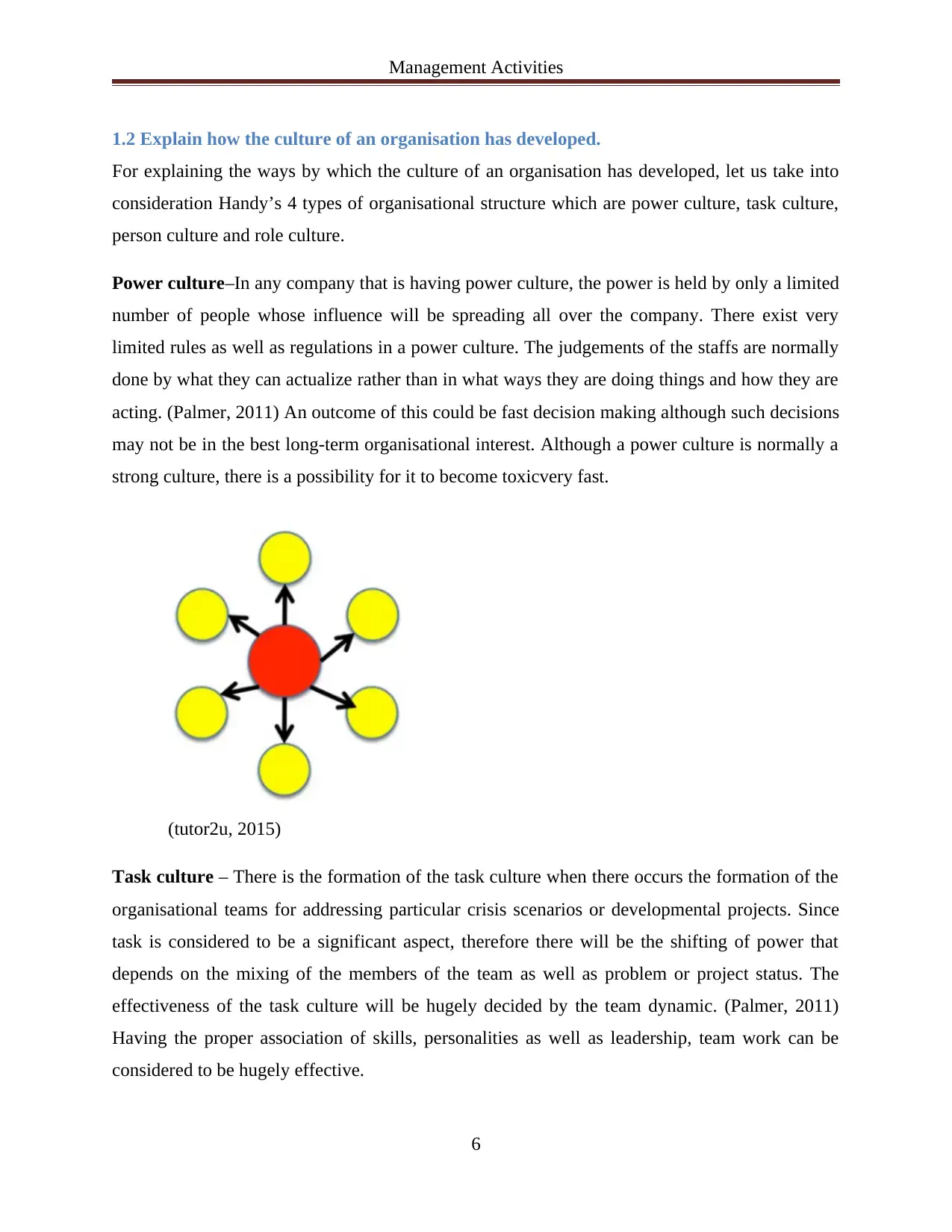
Management Activities
1.2 Explain how the culture of an organisation has developed.
For explaining the ways by which the culture of an organisation has developed, let us take into
consideration Handy’s 4 types of organisational structure which are power culture, task culture,
person culture and role culture.
Power culture–In any company that is having power culture, the power is held by only a limited
number of people whose influence will be spreading all over the company. There exist very
limited rules as well as regulations in a power culture. The judgements of the staffs are normally
done by what they can actualize rather than in what ways they are doing things and how they are
acting. (Palmer, 2011) An outcome of this could be fast decision making although such decisions
may not be in the best long-term organisational interest. Although a power culture is normally a
strong culture, there is a possibility for it to become toxicvery fast.
(tutor2u, 2015)
Task culture – There is the formation of the task culture when there occurs the formation of the
organisational teams for addressing particular crisis scenarios or developmental projects. Since
task is considered to be a significant aspect, therefore there will be the shifting of power that
depends on the mixing of the members of the team as well as problem or project status. The
effectiveness of the task culture will be hugely decided by the team dynamic. (Palmer, 2011)
Having the proper association of skills, personalities as well as leadership, team work can be
considered to be hugely effective.
6
1.2 Explain how the culture of an organisation has developed.
For explaining the ways by which the culture of an organisation has developed, let us take into
consideration Handy’s 4 types of organisational structure which are power culture, task culture,
person culture and role culture.
Power culture–In any company that is having power culture, the power is held by only a limited
number of people whose influence will be spreading all over the company. There exist very
limited rules as well as regulations in a power culture. The judgements of the staffs are normally
done by what they can actualize rather than in what ways they are doing things and how they are
acting. (Palmer, 2011) An outcome of this could be fast decision making although such decisions
may not be in the best long-term organisational interest. Although a power culture is normally a
strong culture, there is a possibility for it to become toxicvery fast.
(tutor2u, 2015)
Task culture – There is the formation of the task culture when there occurs the formation of the
organisational teams for addressing particular crisis scenarios or developmental projects. Since
task is considered to be a significant aspect, therefore there will be the shifting of power that
depends on the mixing of the members of the team as well as problem or project status. The
effectiveness of the task culture will be hugely decided by the team dynamic. (Palmer, 2011)
Having the proper association of skills, personalities as well as leadership, team work can be
considered to be hugely effective.
6
⊘ This is a preview!⊘
Do you want full access?
Subscribe today to unlock all pages.

Trusted by 1+ million students worldwide
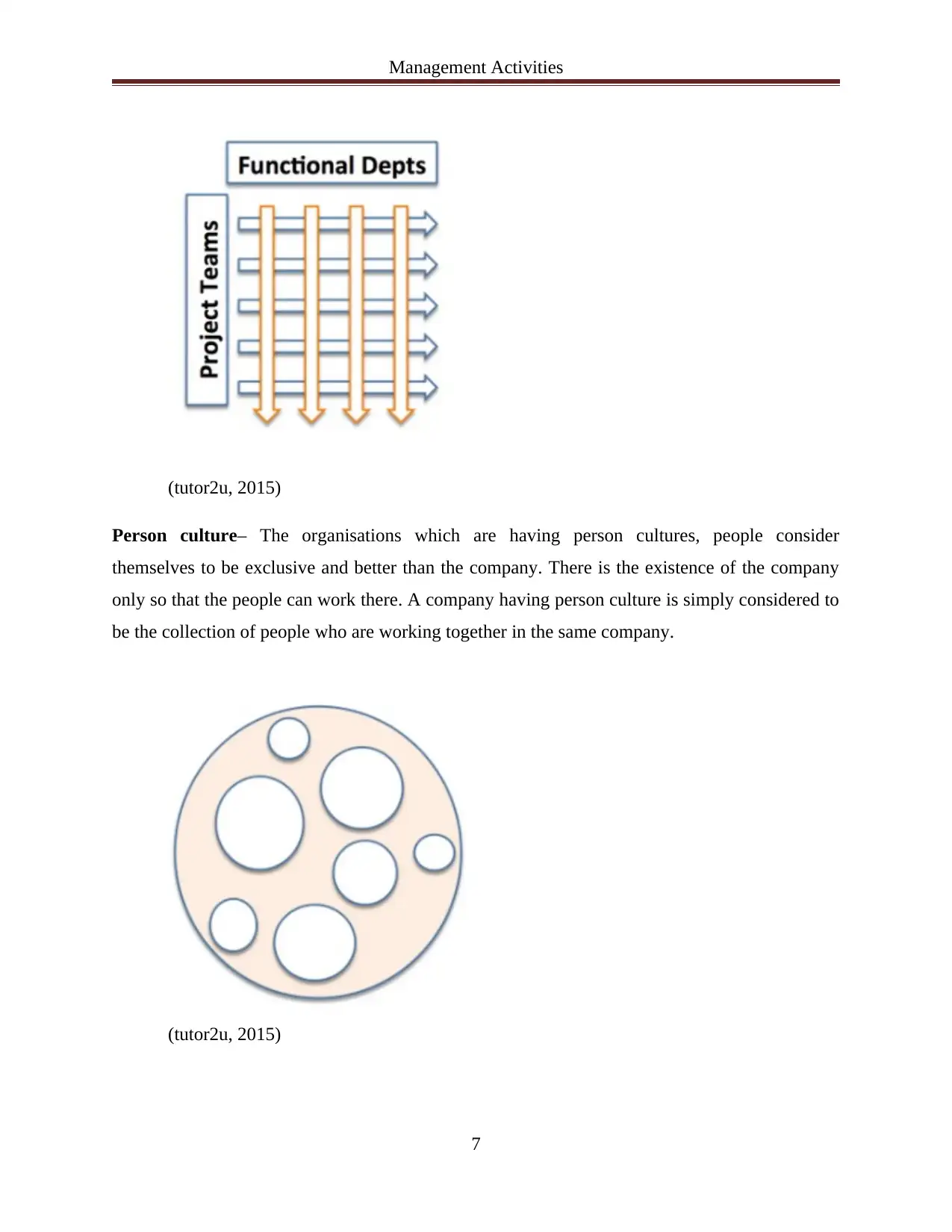
Management Activities
(tutor2u, 2015)
Person culture– The organisations which are having person cultures, people consider
themselves to be exclusive and better than the company. There is the existence of the company
only so that the people can work there. A company having person culture is simply considered to
be the collection of people who are working together in the same company.
(tutor2u, 2015)
7
(tutor2u, 2015)
Person culture– The organisations which are having person cultures, people consider
themselves to be exclusive and better than the company. There is the existence of the company
only so that the people can work there. A company having person culture is simply considered to
be the collection of people who are working together in the same company.
(tutor2u, 2015)
7
Paraphrase This Document
Need a fresh take? Get an instant paraphrase of this document with our AI Paraphraser
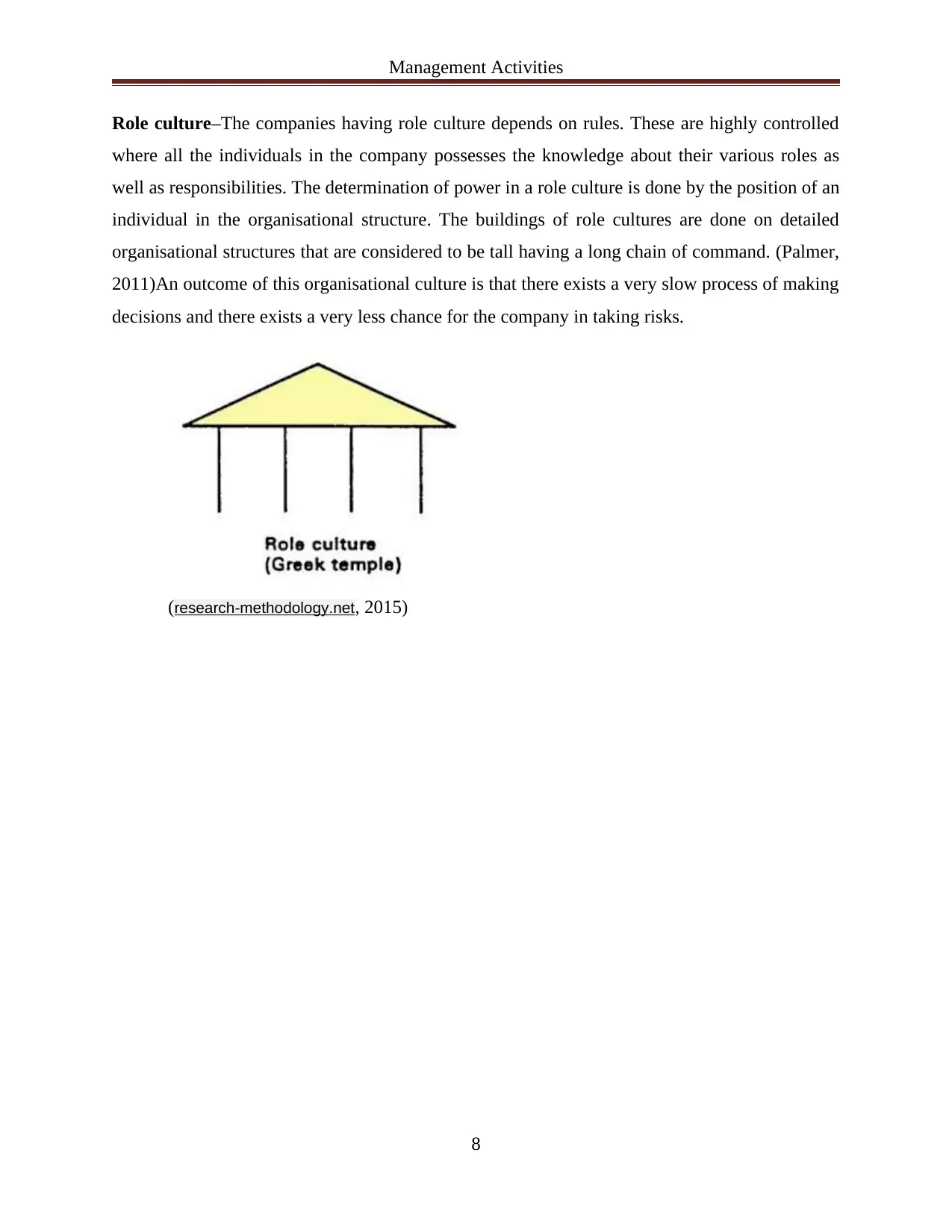
Management Activities
Role culture–The companies having role culture depends on rules. These are highly controlled
where all the individuals in the company possesses the knowledge about their various roles as
well as responsibilities. The determination of power in a role culture is done by the position of an
individual in the organisational structure. The buildings of role cultures are done on detailed
organisational structures that are considered to be tall having a long chain of command. (Palmer,
2011)An outcome of this organisational culture is that there exists a very slow process of making
decisions and there exists a very less chance for the company in taking risks.
(research-methodology.net, 2015)
8
Role culture–The companies having role culture depends on rules. These are highly controlled
where all the individuals in the company possesses the knowledge about their various roles as
well as responsibilities. The determination of power in a role culture is done by the position of an
individual in the organisational structure. The buildings of role cultures are done on detailed
organisational structures that are considered to be tall having a long chain of command. (Palmer,
2011)An outcome of this organisational culture is that there exists a very slow process of making
decisions and there exists a very less chance for the company in taking risks.
(research-methodology.net, 2015)
8
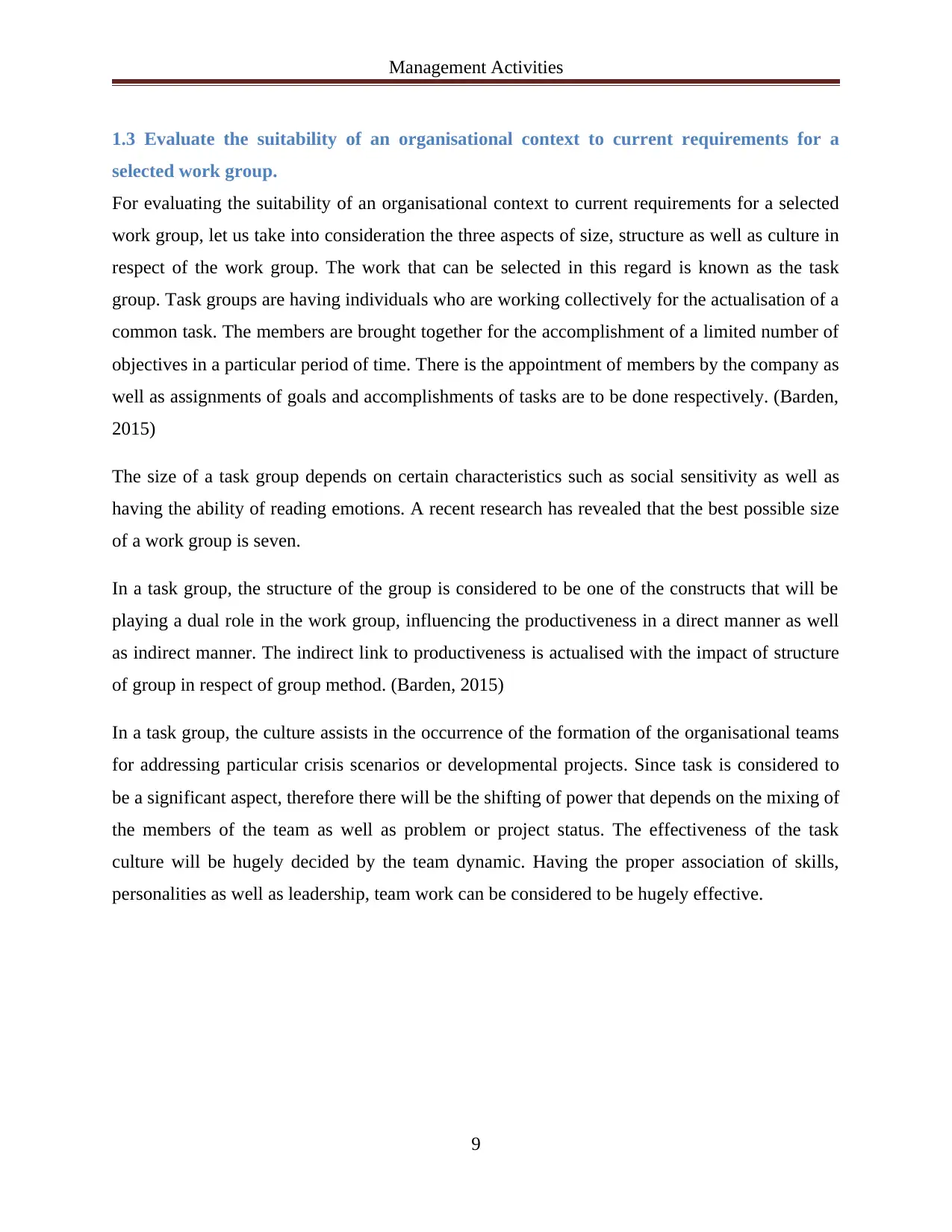
Management Activities
1.3 Evaluate the suitability of an organisational context to current requirements for a
selected work group.
For evaluating the suitability of an organisational context to current requirements for a selected
work group, let us take into consideration the three aspects of size, structure as well as culture in
respect of the work group. The work that can be selected in this regard is known as the task
group. Task groups are having individuals who are working collectively for the actualisation of a
common task. The members are brought together for the accomplishment of a limited number of
objectives in a particular period of time. There is the appointment of members by the company as
well as assignments of goals and accomplishments of tasks are to be done respectively. (Barden,
2015)
The size of a task group depends on certain characteristics such as social sensitivity as well as
having the ability of reading emotions. A recent research has revealed that the best possible size
of a work group is seven.
In a task group, the structure of the group is considered to be one of the constructs that will be
playing a dual role in the work group, influencing the productiveness in a direct manner as well
as indirect manner. The indirect link to productiveness is actualised with the impact of structure
of group in respect of group method. (Barden, 2015)
In a task group, the culture assists in the occurrence of the formation of the organisational teams
for addressing particular crisis scenarios or developmental projects. Since task is considered to
be a significant aspect, therefore there will be the shifting of power that depends on the mixing of
the members of the team as well as problem or project status. The effectiveness of the task
culture will be hugely decided by the team dynamic. Having the proper association of skills,
personalities as well as leadership, team work can be considered to be hugely effective.
9
1.3 Evaluate the suitability of an organisational context to current requirements for a
selected work group.
For evaluating the suitability of an organisational context to current requirements for a selected
work group, let us take into consideration the three aspects of size, structure as well as culture in
respect of the work group. The work that can be selected in this regard is known as the task
group. Task groups are having individuals who are working collectively for the actualisation of a
common task. The members are brought together for the accomplishment of a limited number of
objectives in a particular period of time. There is the appointment of members by the company as
well as assignments of goals and accomplishments of tasks are to be done respectively. (Barden,
2015)
The size of a task group depends on certain characteristics such as social sensitivity as well as
having the ability of reading emotions. A recent research has revealed that the best possible size
of a work group is seven.
In a task group, the structure of the group is considered to be one of the constructs that will be
playing a dual role in the work group, influencing the productiveness in a direct manner as well
as indirect manner. The indirect link to productiveness is actualised with the impact of structure
of group in respect of group method. (Barden, 2015)
In a task group, the culture assists in the occurrence of the formation of the organisational teams
for addressing particular crisis scenarios or developmental projects. Since task is considered to
be a significant aspect, therefore there will be the shifting of power that depends on the mixing of
the members of the team as well as problem or project status. The effectiveness of the task
culture will be hugely decided by the team dynamic. Having the proper association of skills,
personalities as well as leadership, team work can be considered to be hugely effective.
9
⊘ This is a preview!⊘
Do you want full access?
Subscribe today to unlock all pages.

Trusted by 1+ million students worldwide

Management Activities
Task 2
2.1 Discuss the extent to which an operational area of an organisation is customer oriented.
For discussing the extent to which an operational area of an organisation is customer oriented,
the three aspects of feedback from internal and external customers are considered, then ‘inside
out’ and ‘outside in’ approach are considered and finally the segmentation of the customer base
is done.
Before discussing the first aspect of feedback from internal and external customers, let us
understand what is the significance of the internal and external customers. In respect of internal
customers, it can be said that internal customer relationship performs a significant part for the
success of the business. For instance, in an organisation the sales executive who is effectively
performing with customer service might be facing more challenges to place orders or give proper
replies to the queries of the external clients that will result in poor service level. In respect of
external customers, it can be said that they are very much important for the organisational
success since they are providing the revenue flow with the help of their purchases that are
required for the survival of the organisation. The external customers who are satisfied most of
the time are making repeat purchases and referring the name of the company to other individuals.
Now coming back to the aspect of feedback from internal and external customers,three aspects
can be considered which are suggestion boxes, taking advantage of current technological aspects
as well as never frustrating the rumours. (Barden, 2015) The suggestion boxes are generally
utilised for tapping into the viewpoints, complaints as well as feedbacks of internal and external
customers. In respect of taking advantage of current technological aspects, the companies are
required taking advantage of current technological aspects for reaching out to their customers
and getting the correct feedbacks in respect of their products, services and so on. In respect of
never frustrating the rumours, it is said that it is very much significant in listening to the internal
and external customer’s conversations in respect of the company that might be good or bad since
that gives the scope for constant development. (Barden, 2015) But if the rumours get frustrated
then the customers will quietly leave if a chance is given.
Let us now take into consideration the ‘inside out’ versus ‘outside in’ approach. The ‘inside out’
approach is directed by the belief that the organisational strengths and organisational capabilities
10
Task 2
2.1 Discuss the extent to which an operational area of an organisation is customer oriented.
For discussing the extent to which an operational area of an organisation is customer oriented,
the three aspects of feedback from internal and external customers are considered, then ‘inside
out’ and ‘outside in’ approach are considered and finally the segmentation of the customer base
is done.
Before discussing the first aspect of feedback from internal and external customers, let us
understand what is the significance of the internal and external customers. In respect of internal
customers, it can be said that internal customer relationship performs a significant part for the
success of the business. For instance, in an organisation the sales executive who is effectively
performing with customer service might be facing more challenges to place orders or give proper
replies to the queries of the external clients that will result in poor service level. In respect of
external customers, it can be said that they are very much important for the organisational
success since they are providing the revenue flow with the help of their purchases that are
required for the survival of the organisation. The external customers who are satisfied most of
the time are making repeat purchases and referring the name of the company to other individuals.
Now coming back to the aspect of feedback from internal and external customers,three aspects
can be considered which are suggestion boxes, taking advantage of current technological aspects
as well as never frustrating the rumours. (Barden, 2015) The suggestion boxes are generally
utilised for tapping into the viewpoints, complaints as well as feedbacks of internal and external
customers. In respect of taking advantage of current technological aspects, the companies are
required taking advantage of current technological aspects for reaching out to their customers
and getting the correct feedbacks in respect of their products, services and so on. In respect of
never frustrating the rumours, it is said that it is very much significant in listening to the internal
and external customer’s conversations in respect of the company that might be good or bad since
that gives the scope for constant development. (Barden, 2015) But if the rumours get frustrated
then the customers will quietly leave if a chance is given.
Let us now take into consideration the ‘inside out’ versus ‘outside in’ approach. The ‘inside out’
approach is directed by the belief that the organisational strengths and organisational capabilities
10
Paraphrase This Document
Need a fresh take? Get an instant paraphrase of this document with our AI Paraphraser
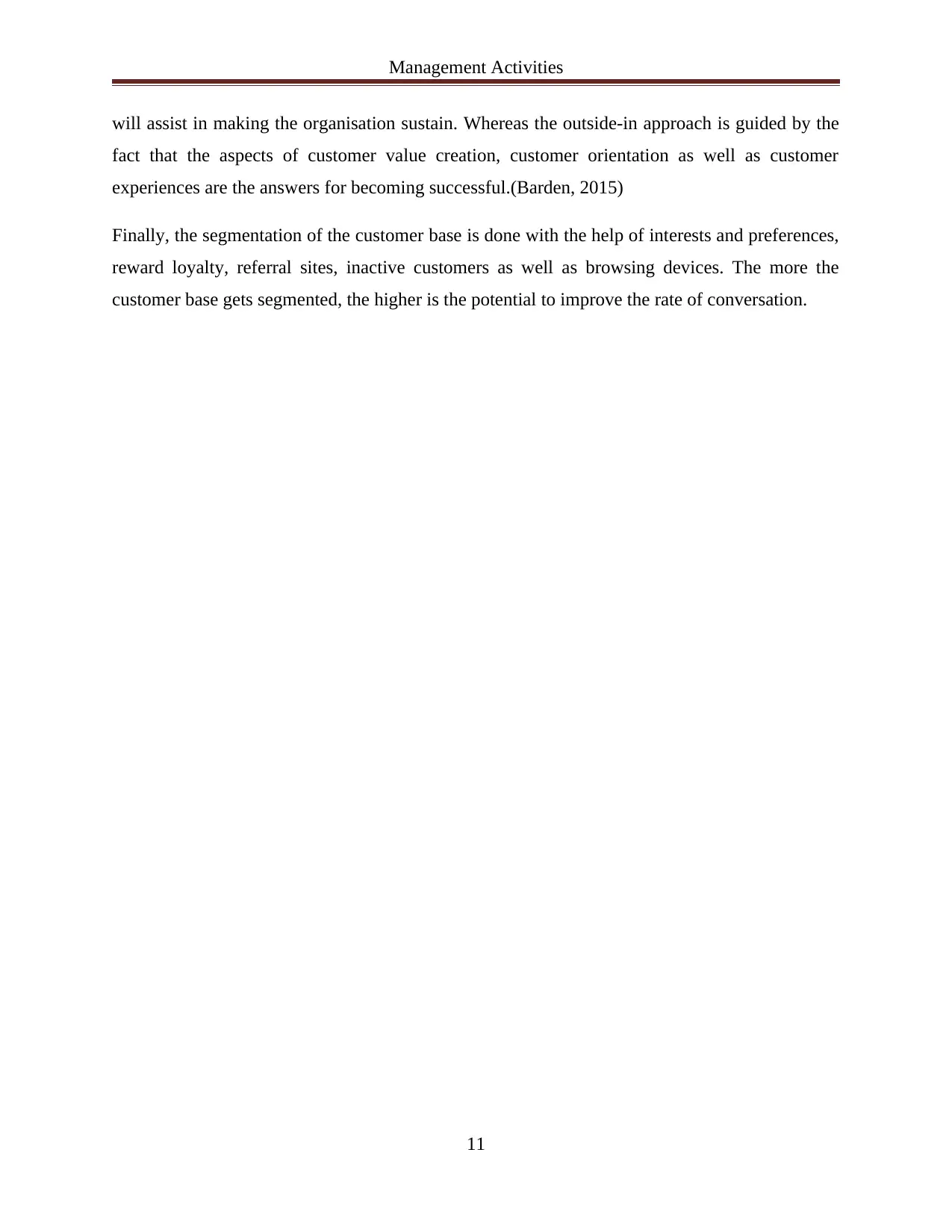
Management Activities
will assist in making the organisation sustain. Whereas the outside-in approach is guided by the
fact that the aspects of customer value creation, customer orientation as well as customer
experiences are the answers for becoming successful.(Barden, 2015)
Finally, the segmentation of the customer base is done with the help of interests and preferences,
reward loyalty, referral sites, inactive customers as well as browsing devices. The more the
customer base gets segmented, the higher is the potential to improve the rate of conversation.
11
will assist in making the organisation sustain. Whereas the outside-in approach is guided by the
fact that the aspects of customer value creation, customer orientation as well as customer
experiences are the answers for becoming successful.(Barden, 2015)
Finally, the segmentation of the customer base is done with the help of interests and preferences,
reward loyalty, referral sites, inactive customers as well as browsing devices. The more the
customer base gets segmented, the higher is the potential to improve the rate of conversation.
11

Management Activities
2.2 Evaluate the use of operational management techniques in a specific context.
For the evaluation of the use of operational management techniques in a specific context, let us
take into consideration the two techniques which are management by objectives (MBO) and
business process modelling.
Management by objectives (MBO)
Management by objectives is considered to be a model of management that focuses on
improving the organisational performance through objectives that are clearly defined that the
management as well as the staffs have agreed to. To provide their viewpoint regarding the setting
of goals and action plans makes sure that there exists improved participation as well as staff
commitment and also the configuration of goals across the companies. A significant feature of
the management by objectives is establishing the management information system for measuring
the actual performances as well as achievements against the definite goals. The main advantages
of MBO are associated with improving with motivation and commitment of the staff and
ensuring improved communication amongst the management as well as the staffs. (Palmer,
2011)The MBO cycle is associated with setting corporate objectives, setting and aligning staff
objectives, monitoring performance, evaluating performance, and finally rewarding the staffs.
(tutor2u, 2015)
12
2.2 Evaluate the use of operational management techniques in a specific context.
For the evaluation of the use of operational management techniques in a specific context, let us
take into consideration the two techniques which are management by objectives (MBO) and
business process modelling.
Management by objectives (MBO)
Management by objectives is considered to be a model of management that focuses on
improving the organisational performance through objectives that are clearly defined that the
management as well as the staffs have agreed to. To provide their viewpoint regarding the setting
of goals and action plans makes sure that there exists improved participation as well as staff
commitment and also the configuration of goals across the companies. A significant feature of
the management by objectives is establishing the management information system for measuring
the actual performances as well as achievements against the definite goals. The main advantages
of MBO are associated with improving with motivation and commitment of the staff and
ensuring improved communication amongst the management as well as the staffs. (Palmer,
2011)The MBO cycle is associated with setting corporate objectives, setting and aligning staff
objectives, monitoring performance, evaluating performance, and finally rewarding the staffs.
(tutor2u, 2015)
12
⊘ This is a preview!⊘
Do you want full access?
Subscribe today to unlock all pages.

Trusted by 1+ million students worldwide
1 out of 32
Related Documents
Your All-in-One AI-Powered Toolkit for Academic Success.
+13062052269
info@desklib.com
Available 24*7 on WhatsApp / Email
![[object Object]](/_next/static/media/star-bottom.7253800d.svg)
Unlock your academic potential
Copyright © 2020–2025 A2Z Services. All Rights Reserved. Developed and managed by ZUCOL.




